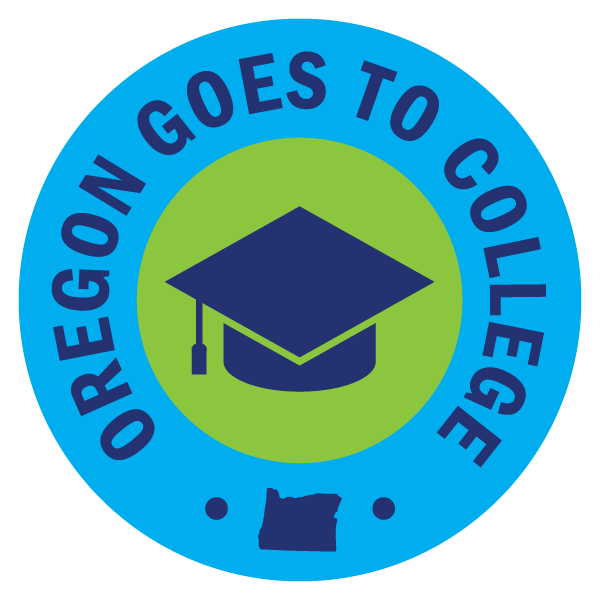
Learn how to teach students and families about college financial aid options.
Financial aid is any form of funding that helps a student pay for college.
Table of contents
- What is financial aid?
- Why financial aid matters
- Financial aid obstacles
- A word about loans
- How to help students
- Additional resources
★ = Oregon Goes To College resource
What is financial aid?
Financial aid is money used to pay for college expenses. College expenses include tuition and fees, housing, transportation, books, and supplies. Students might also have other expenses related to living and studying. Financial aid can help pay for most college costs.
No matter their grades, family income, or location, anyone can receive financial aid. Financial aid includes grants, scholarships, work-study, and loans. Financial aid can be based on need or merit. It can come from the government, colleges or universities, or private sources.
Why financial aid matters
Many students need financial aid to afford college. In fact, more than 85% of college students receive financial aid to pay for school.
Most students will use more than one type of aid to pay for college. Students and families need to learn about the different types of aid and how to apply for them. The earlier they learn, the better they can plan.
Financial aid obstacles
Not understanding the cost of college
It is hard for students and families to know the cost of education without a college's financial aid offer. To help families budget, colleges are required to include a net price calculator on their websites. Students and families can use this tool to estimate costs.
Many students who qualify for selective schools do not apply because they think they cannot afford them. Students and families need to know about all their financial aid options. Otherwise, students may "undermatch," meaning they end up at a less selective college.
Confusing language and forms
Financial aid has its own language full of jargon and acronyms. Applications can be long and hard to fill out. This makes some students and families avoid applying for financial aid. They need to learn the language and understand what it is saying to apply for it.
Not all financial aid applications are the same. Completing the FAFSA or ORSAA is not the same as applying for scholarships or getting grants.
Students and families may get confused by the different forms. That can lead to students not filling out the forms they need to receive money to help them pay for college.
A word about loans
For many students, loans are a necessary part of paying for a college education. This is especially important for students from low-income families. These students:
- tend to rely more on family resources, scholarships, and grants.
- are less likely than their wealthier peers to take out loans for college.
- may not consider loans to help pay for college, limiting their choices.
- might have fewer college choices, resources, and career opportunities.
- may work more hours.
When students and families understand their financial aid options, including loans, they can choose the best college for them.
How to help students
One of the best ways to help students and families prepare for the financial aid process is to involve everyone and talk about financial aid — as early as middle school. Ensure both families and students have the same information and know what is happening. When students are in 12th grade, you should also offer support with financial aid applications.
All grade levels
Talk about financial aid early and often
- Discuss the various types of financial aid with students and families. Explain how to apply and what information is needed.
- Our handouts, 6 Ways to Pay for College handouts ★ (English / Spanish) and Parent Information & Financial Aid Forms ★ provide more information on financial aid.
- Talk about FAFSA and ORSAA whenever you talk about financial aid. There are many reasons why this is important:
- Oregon is dedicated to help undocumented students through state aid. Sharing information on FAFSA and ORSAA normalizes applying for financial aid, no matter your immigration status.
- You may think you know the immigration status of all students, but you may not.
- Even if you do not have undocumented students, they may have undocumented friends and family. Students learn a lot about the college going process from their peers, so help students share accurate information.
- Help students and families understand the language of financial aid with our 101 College Terms ★ or 101 College Trivia ★.
- Instruct students and families about the cost of college and the difference between sticker price and net price.
Check out the Department of Education's net price calculator to see how much colleges cost.
Host a family financial aid night
- Download our 6 Ways to Pay for College Presentation ★ to introduce the basics of financial aid. This presentation includes activities and speaker notes.
- Use our Request a Financial Aid Speaker form ★ to connect with an expert for your event.
- Request a financial aid presentation through OSAC.
Use our checklists to explore ways to pay for college
- Middle School: College Checklist ★
- 9th Grade: College Checklist ★
- 10th Grade: College Checklist ★
- 11th Grade: College Checklist ★
- 12th Grade: College Checklist ★
Include financial aid and financial literacy lessons in classes
- Introduce the language of financial aid with fun games like the Financial Aid Swat! Game ★.
- Explore personal finance with students.
- Financial Beginnings has free lessons that teach how to play and active role in financial well-being.
Middle school
Build awareness and familiarity with financial aid
- Introduce financial aid concepts at back-to-school nights.
- Our handout 6 Ways to Pay for College ★ will help you get started.
- Use Financial Conversation Starters for Middle and High School Students ★ and Financial Conversations with Parents ★ to guide students and their families in talking and thinking about money.
- Encourage students to apply for scholarships now.
- Finaid.org provides scholarships for students under age 13.
- Scholarship 360 has scholarship listings for middle school students.
- Invite the Oregon Treasury to talk about the Oregon College Savings Plan to families.
9th-10th grade
Continue to build college-going habits with students and families while teaching about financial aid
- Encourage students to track activities for future scholarship applications using our Activities Chart ★.
- Use Financial Conversation Starters for Middle and High School Students ★ and Financial Conversations with Parents ★ to guide students and their families in talking and thinking about money.
- Encourage students to apply for scholarships now.
- Scholarship 360 has opportunities for students in 9th and 10th grades.
11th grade
Prepare students and families to apply for financial aid
- Host a Junior College Night or Financial Aid Night for students and families in the spring.
- Use our sample Financial Aid Night Agenda ★ or sign up to host an ECMC College Night where you can award a $1,000 scholarship to a student attendee.
- Encourage students to track activities for future scholarship applications using our Activities Chart ★.
- Instruct students and families on what a financial aid offer looks like.
- Use our Financial Aid Offer Challenge ★ activity to introduce students to financial aid offers.
12th grade
Set a goal to increase FAFSA/ORSAA completion
- Join the FAFSA+ program to get student level data for your school.
- Encourage students to create an FSA ID by printing and hanging our FSA ID Flyer ★.
- Use our FAFSA/ORSAA Tracker Poster ★ to keep track of your success.
- Make it a competition with local schools.
Assist families and students with financial aid applications
- Host a Senior College Night or Financial Aid Night for students and families in the fall.
- Use our sample Financial Aid Night Agenda ★ or sign up to host an ECMC College Night where you can award a $1,000 scholarship to a student attendee.
- Use a timeline, like our Financial Aid Timeline ★, to help students track important dates and deadlines for financial aid.
- In Oregon, this timeline may include dates for FAFSA and ORSAA, Oregon Promise Grant, The Ford Family Foundation, and OSAC scholarships.
- Host FAFSA/ORSAA completion events in the fall.
- Join College Goal Oregon.
- Download the 24-25 FAFSA-ORSAA FAQs ★ to help answer questions.
- Participate in College Application Week ★.
- Encourage students to complete financial aid and college applications.
- Help students who are selected for verification keep track of information requested by using our Financial Aid Verification Tracker ★.
Help students and families understand financial aid award offers
- Use our Compare Costs and Financial Aid ★ document to help students make smart choices about costs.
- Share our page on How to compare financial aid offers ★.
- Inform students on how to write a financial aid appeal.
Share information about financial aid with students and families
- Send out financial aid reminders using text messages or social media.
- Share our financial aid posts on Instagram and Facebook, or create your own.
- Share our Scholarship Calendar ★ with students.
- Encourage students to track scholarships they qualify for on our Scholarship List ★ document.
- Show our Scholarship Slides ★ on your electronic display boards.
Additional resources
- FAFSA Help Center
- Guide to the ORSAA
- ORSAA tip sheets (English and Spanish)
- Free OSAC publications and resources
